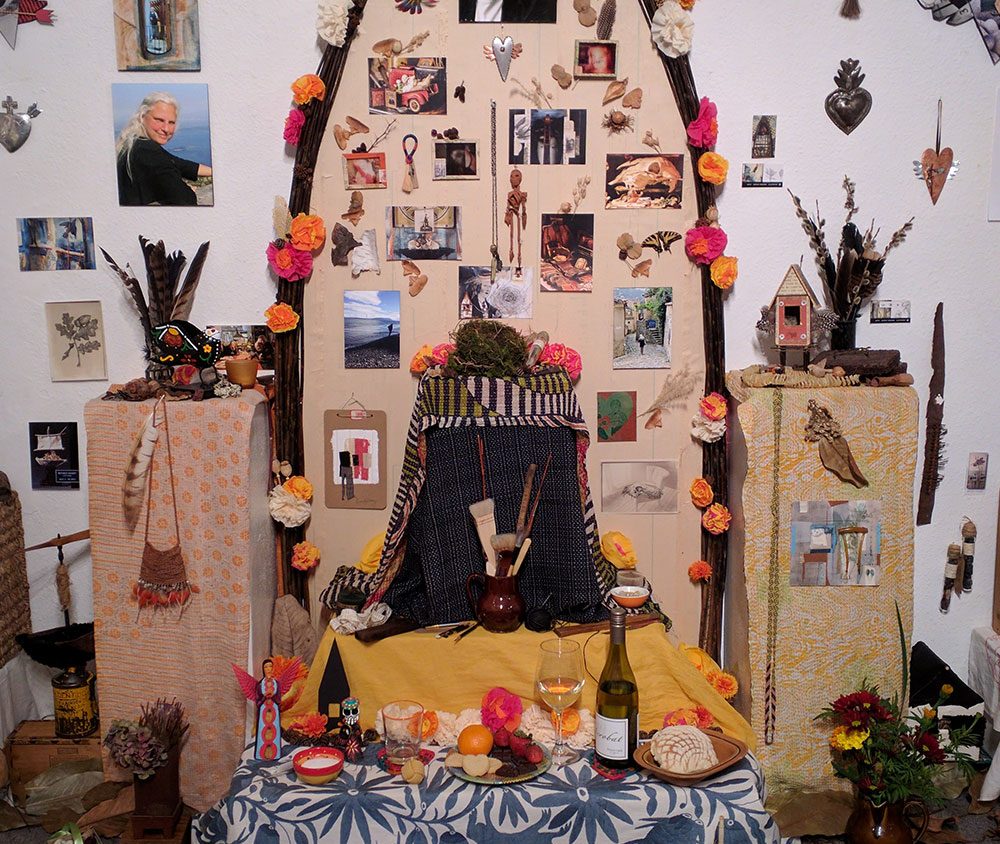If the dead come back it’s usually not to picnic. But that’s how Melissa Sikes represents skeletons back from the dead in one of her small, square and colorful paintings in the annual Día de los Muertos exhibit running through Nov. 2 at Maude Kerns Art Center.
In other paintings, Sikes pictures skeletons doing a whole host of activities only people with muscles should be able to do: playing drums or just sitting at a table enjoying a meal.
Mainstream culture’s concept of the dead returning is connected to haunting. As so many horror movies posit, they are taking care of unfinished business. But Thalia Lerin, another of the 22 artists selected for the MKAC exhibit, depicts in one of her porcelain plates a pair of skeletons bound in eternal love. On another, a skeletal Frida Kahlo is shown having a pleasant interaction with an equally skeletal bird, echoing the famous Mexican artist’s own self-portraits.
MKAC Director Michael Fisher says Fernando Soto’s photographs add something special to this year’s show. The prizewinning Mexican photojournalist’s work features the unique Día de los Muertos practice of hanging altars, and Soto will give an art talk on Oct. 31 that relates to the holiday as it’s celebrated in Morelos, Mexico, especially in Coatetelco.
On Oct. 24, the center will have a viewing of Coco, which won last year’s Oscar for best animated feature film. “Movies at Maude” Thursdays are usually reserved for films about art, Fisher says, but Coco is inspired by Día de los Muertos.
Free Family Fun Day on Oct. 26 will include the holiday’s tradition of sugar skull making. Katherine Gorham started making them with her middle school class, and she’ll be on hand to show how to decorate the skulls with brightly colored frosting and foil.
A gift shop featuring arts and crafts handmade from artisans in Mexico rivals that of any folklore museum.
The art on the walls in the rest of the gallery was selected by a panel of jurists, but the altars — specially made for the space at the center — were not. Individuals proposed them informally and they were chosen based on how well they adhered to the holiday’s tradition of altar-making.
According to tradition, the dead return each Nov. 1 and 2 to take part in things they did when alive.
The altars welcome them back.
Among the seven altars in the exhibit are three for women who were influential in Eugene’s art community: Maude Kerns (1876-1965), Lotte Streisinger (1927-2017) and Beverly Soasey (1950-2018).
Large and multi-layered, they cannot be taken in by a moment’s glance. The one for Kerns is perhaps the simplest in terms of construction. Its color scheme is black and white with yellow and orange colors delivered in the form of fruits and flowers. It contains a decanter that might hold alcohol and a plate of Oreo cookies.
Who knew Kerns liked those things? Did she enjoy them together? If you’re curious about her art, check out the pieces on the wall beside her altar.
A nonobjective painter in the days when that style was new, Kerns donated the property where the center now resides. Every year a group of volunteers makes an altar to her.
Soasey was affiliated with the MKAC and the Karin Clarke Gallery. She was also director of the former Jacobs Gallery. The altar to her is put together much the way she used to design her “assemblages,” with a variety of found objects, paint brushes, hearts, pictures and art. Photographs show her in youth and before she died. They show her in the places she loved — one of which was the ocean.
Streisinger was German and Jewish, significant because she was able to leave Europe for the United States in 1937, escaping World War II. She was a potter who married a molecular biologist at the University of Oregon and was heavily involved in the peace movement. She began a holiday craft sale for the Eugene Peace Information Center, and then seeing a need for a more frequent sale, helped found Eugene’s Saturday Market. She also hosted the show “Viz City” on KLCC.
Streisinger’s art is included in her altar. Beside it, available for viewing, are two books she wrote: one about art, the other about the Institute of Molecular Biology at the UO.
A few days before I saw this show I noticed a Day of the Dead mask — a skull painted with flowers — selling in the Halloween section at Rite Aid. Much has been made recently of cultural appropriation. In 2017 a burrito food truck was reportedly forced to shut down in Portland due, in part, to cultural appropriation.
While there’s no arguing that point here, you could also make the case that embracing the material culture of this Mexican holiday is transforming the way we look at the dead: not as zombies or ghosts returning to haunt us, but as skeletons back for a picnic.
Borrowing or appropriating (or adapting) traditions of Día de los Muertos, we can make altars at the annual exhibit at Maude Kern Art Center, or just remember the things people we lost enjoyed when they were with us — things still present, like cookies, painting, the ocean and clay.
